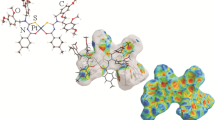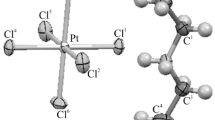Abstract
A compound of the prodigiosene type chromophore has been prepared and its carrier mediated transport properties for nearly all physiologically important cations determined using a bulk membrane system. This ligand is a very effective ionophore for these cations without pronounced selectivities. The mechanistic implications of complexation behaviour of the ligand for its transport characteristics are discussed: The physiological (bacteriostatic, fungistatic, antimitotic and toxic) properties of the prodigiosenes may be fundamentally correlated to their pronounced ionophoric properties.
Similar content being viewed by others
Literatur
Mitt.:Eichinger D, Falk H (1987) Monatsh Chem 118: 91
Williams RP, Hearn WR (1967) Antibiotics II: 410
Gerber N (1975) Critical Rev Microbiol 1975: 469
Alonzo V (1984) L'Igiene Moderna 81: 557
Rapoport H, Castagnoli N (1962) J Amer Chem Soc 84: 2778
Rapoport H, Holden KG (1962) J Amer Chem Soc 84: 635
Hearn WR, Elson MK, Williams RH, Medina-Castro J (1970) J Org Chem 35: 142
Berner H, Schulz G, Reinshagen H (1977) Monatsh Chem 108: 233, 285, 915; (1978) 109: 137
Wir schlagen im Gegensatz zur Bezifferung des „Prodigiosins“ in Lit. [7] die in der Formelübersicht angegebene vor. Sie entspricht eher der Bezifferung von Tripyrrinen und Bilinen
Fischer H (1941) Org Synth 21: 67
Plieninger H, Kurze J (1964) Ann Chem 680: 60
Silverstein RM, Ryskiewitz EE, Willard C, Köhler RC (1955) J Org Chem 20: 668
Eichinger D, Falk H (1982) Monatsh Chem 113: 355
Rosano H, Schulman JH, Weisbuch JB (1961) Ann NY Acad Sci 92: 457
Williams DR (1971) The metals of life. Van Nostrand Reinhold, London;Kiem J, Feinendegen LE (1985) Chem Lab Betr 36: 540
D'Ans-Lax (1967) Taschenbuch für Chemiker und Physiker, 3 Aufl. Springer, Berlin Heidelberg New York
Lamb JD, Christensen JJ, Oscarson JL, Nielsen BL, Asay BN, Izatt RM (1980) J Amer Chem Soc 102: 6820;Lehn JM, Behr JP, Kirch M (1985) J Amer Chem Soc 107: 241
Hilgenfeld R, Sänger W (1982) In: Host guest complex chemistry II. Top Curr Chem 101: 3
Author information
Authors and Affiliations
Rights and permissions
About this article
Cite this article
Eichinger, D., Falk, H. Beiträge zur Chemie der Pyrrolpigmente, 69. Mitt.: Tripyrrine vom Prodigiosentyp als Ionophore. Monatsh Chem 118, 255–260 (1987). https://doi.org/10.1007/BF00810058
Received:
Accepted:
Issue Date:
DOI: https://doi.org/10.1007/BF00810058




